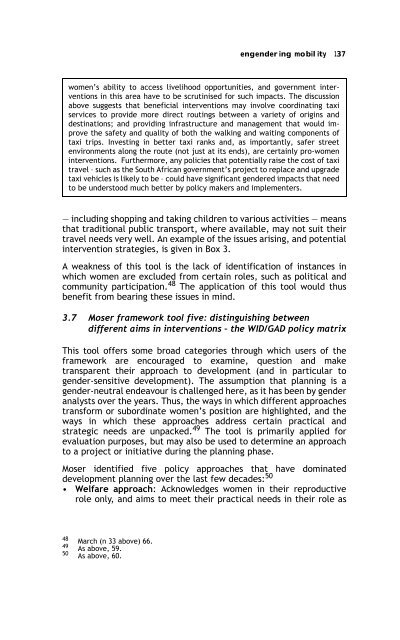Sex, Gender, Becoming - PULP
Sex, Gender, Becoming - PULP
Sex, Gender, Becoming - PULP
You also want an ePaper? Increase the reach of your titles
YUMPU automatically turns print PDFs into web optimized ePapers that Google loves.
engendering mobility 137<br />
women’s ability to access livelihood opportunities, and government interventions<br />
in this area have to be scrutinised for such impacts. The discussion<br />
above suggests that beneficial interventions may involve coordinating taxi<br />
services to provide more direct routings between a variety of origins and<br />
destinations; and providing infrastructure and management that would improve<br />
the safety and quality of both the walking and waiting components of<br />
taxi trips. Investing in better taxi ranks and, as importantly, safer street<br />
environments along the route (not just at its ends), are certainly pro-women<br />
interventions. Furthermore, any policies that potentially raise the cost of taxi<br />
travel – such as the South African government’s project to replace and upgrade<br />
taxi vehicles is likely to be – could have significant gendered impacts that need<br />
to be understood much better by policy makers and implementers.<br />
— including shopping and taking children to various activities — means<br />
that traditional public transport, where available, may not suit their<br />
travel needs very well. An example of the issues arising, and potential<br />
intervention strategies, is given in Box 3.<br />
A weakness of this tool is the lack of identification of instances in<br />
which women are excluded from certain roles, such as political and<br />
community participation. 48 The application of this tool would thus<br />
benefit from bearing these issues in mind.<br />
3.7 Moser framework tool five: distinguishing between<br />
different aims in interventions – the WID/GAD policy matrix<br />
This tool offers some broad categories through which users of the<br />
framework are encouraged to examine, question and make<br />
transparent their approach to development (and in particular to<br />
gender-sensitive development). The assumption that planning is a<br />
gender-neutral endeavour is challenged here, as it has been by gender<br />
analysts over the years. Thus, the ways in which different approaches<br />
transform or subordinate women’s position are highlighted, and the<br />
ways in which these approaches address certain practical and<br />
strategic needs are unpacked. 49 The tool is primarily applied for<br />
evaluation purposes, but may also be used to determine an approach<br />
to a project or initiative during the planning phase.<br />
Moser identified five policy approaches that have dominated<br />
development planning over the last few decades: 50<br />
• Welfare approach: Acknowledges women in their reproductive<br />
role only, and aims to meet their practical needs in their role as<br />
48 March (n 33 above) 66.<br />
49<br />
As above, 59.<br />
50 As above, 60.
















